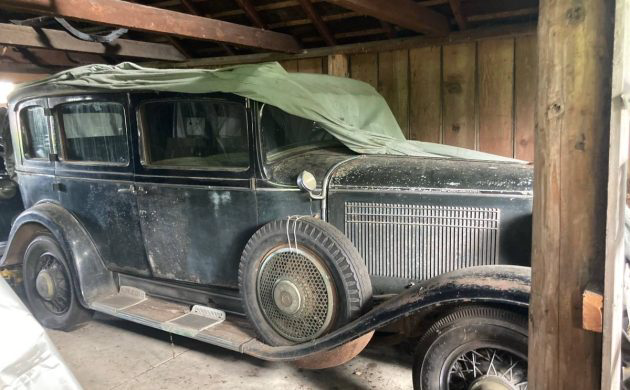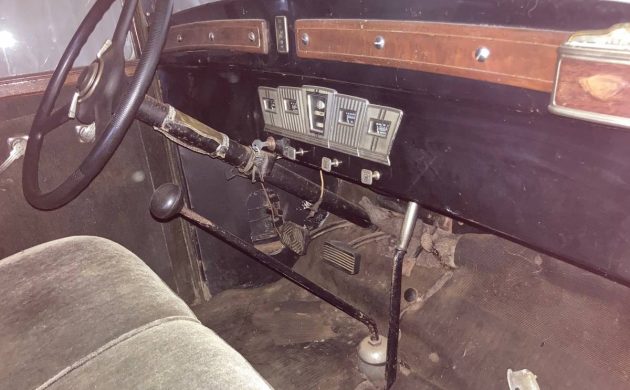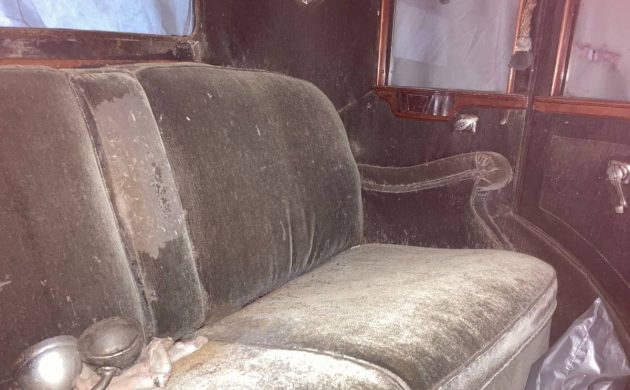Rarity, it seems, is becoming a very fluid concept. We have all seen sign boards at car shows claiming that a particular car is one of a handful left in existence. Yet, if you are a loyal Barn Finds reader, you regularly read about cars that have been hidden away for decades. How many more vintage cars, trucks, and motorcycles are out there waiting to be discovered? This 1930 Chrysler Series 77 sedan for sale on Craigslist in Sumner, Washington is proof that we have no idea whatsoever about the vehicles still out there waiting to be discovered. This Chrysler has been hidden away for an amazing 67 years with just one brief move a few years ago. While not a rare car, it has the potential to be a very nice car to enjoy on antique automobile tours or for simply loading up the neighborhood kids and going for ice cream on a balmy Saturday night. The only stumbling block is the $10,000 asking price. Is that a realistic figure for a solid but needy Depression-Era sedan? Thanks to T.J. for the awesome find!
By 1930, Walter P. Chrysler had solidified the empire he created from its Maxwell and Chalmers roots. His company was on almost equal footing with General Motors and Ford. Furthermore, it was gaining a reputation as an automaker that offered innovation through superior engineering. Debuting in 1930, the Chrysler Series 77 was a rolling embodiment of all that the company stood for. This inline-six-cylinder powered car boasted a four-speed transmission, hydraulic brakes on all four corners, aluminum pistons, full-pressure lubrication, a tubular front axle, and a top speed of 77 miles per hour. As proof of the advanced nature of the company’s products, Chryslers were already establishing a racing record in Europe at storied places like Spa and LeMans. Some considered them “Budget Bentleys.”
While time has marched on and this incredible performance for 1930 was soon eclipsed, the Chrysler Series 77 is widely regarded as a milestone car for the company. It is also a very desirable classic to own today because its performance makes it suitable for use on today’s roads in a much safer fashion than its contemporaries. The only drawback to restoring one other than the current cost of machine work and chrome plating would be the availability of parts. While there are parts out there if you look, it isn’t as easy to find what you need as it would be for a Ford Model A.
We aren’t told very much about this 1930 Chrysler in the ad. The seller states that it was purchased around ten years ago from the original family. They were local to the seller and had stored the car since 1957. The seller, unfortunately, does not give us the details about how the car was found or if the car was known by them for some time before the sale. While these little things do not matter in the broad scheme of things, it is important to know as much as possible about such vehicles and just as important to make sure the stories don’t pass away with a sale or with the original owners.
We are told that the car is original inside and out. That likely does not include the material that covers the spare tire and the grille. The louvers on the hood are also unusual in comparison to other Series 77 Chryslers. There is also plenty of what the seller calls “road rash,” but what that means is unclear. Inside, the upholstery is said to be worn but complete. That is good news because there seems to be enough still there to provide a pattern and to assist in finding a properly matching replacement material. Perhaps the best news of all is that the car is free from rust.
A peek into the backseat reveals how luxurious these early Chryslers were. This looks more like a formal sofa than a back seat. We can also see rich woodgraining on the trim pieces and even a pull strap to assist passengers in exiting the back seat. Chrysler’s plan was to offer a superior car to competitors such as Buick and Cadillac at a lower price. That philosophy seems to be on full display in this car once you look past the dust and cobwebs.
Above is a picture of what the seller tells us is the original engine. Everything seems to be in place and period correct. Sadly, we are not told if the engine freely rotates, but we assume that it is in no shape to run at the moment. The wrap around the fuel line and the homemade plate shielding the carburetor from the heat of the exhaust manifold is evidence that the car had issues with vapor locking. The rag in the cowl and the red object on the driver’s side of the cowl are also puzzling. If any readers have any idea why these items are there or what they are for, please share your thoughts in the comments.
Taken as a whole, this is a very tempting project. The body is solid, all of the parts are there, and the reputation of the Chrysler 77 makes this a desirable car if you are into actually driving prewar cars. It is a safe bet that the interior smells like the world’s biggest mouse nest after all of these years and there are certainly some negative surprises in store for the new owner. However, it would be interesting to see what this car was like after being pulled out into the sun and cleaned thoroughly. A good once-over of the engine would also be helpful. The biggest obstacle to the sale is that the market will likely not support the asking price. However, the car will sell at some point. Whoever gets this Chrysler and puts the effort in may have quite an enjoyable classic car when they finish with it.









This is cool! I love the radiator grille, that spare tire hubcap? is wild, the vertical slats on the front bodywork, the very Art Deco instruments, the overstuffed library-chair seating…. I even like the color. I’m not sure he’ll get his price, but this Chrysler has nifty attributes. I think the red you see by the cowl is the remainder of a label.
I like it too, but not his asking price. Face it folks, it’s a 94 year old car that’s gonna need everything. You might be able to get some of what you need at NAPA to get started on it
and if Kanter Automotive in Boonton,
New Jersey is still around, you can still get the parts to make it run, drive,
and stop. Your local upholstery shop
can help you get the fabric you’ll need
for the seats and door cards, and the
wood trim, you might wanna tackle that yourself if you possess the knowledge. The engine should be easy to coax into running condition
but that updraft carb is a bit scary for
me-& especially when you go to prime
it. Don’t care for it being too near the
exhaust pipe either. If done wrong,
the fire department will be roasting
weenies over your purchase should
a flash fire break out. Other than that,
it’s a cool old car that’s going into my
Vintage Tin file to make art prints of
it someday. There’s an even more rare model of the 77 that I saw 10 years ago that piqued my interest as
it had an extra set of headlights mounted up high on either side of the
windshield frame. Dunno how that
arrangement worked, but it was very
unusual to see. Now THAT’S how we
used to find ’em when I was a kid!
Yes it is a nice car. The carb is a down draft fed by a vacuum tank. Not an updraft.
Actually, the carb is fed by a mechanical fuel pump. Trace the wrapped fuel line to the lower right corner of the photo. That’s the diaphragm type fuel pump. I believe 1930 was the first year for the mechanical fuel pump on Chrysler products.
Dennis. If you follow the fuel line down from the float bowl you will see a normal fuel pump in the lower right hand side of the photo. The cannister thing on the firewall (upper left hand side of the photo) might be a throw-away oil filter for the full pressure lubrication. The oil filters were fitted to the engine when Chrysler fitted its “Floating Power” but the engine in this car is bolted to the frame without rubber engine mounts so the oil filter could go anywhere as the copper pipes leading to it vibrate at the same frequency as the rest of the car.
This is a great write up, thank you for finding this. In my mind, this is what a great barn find is all about It looks like a solid car, and I agree, the upholstery is like something out of a library or parlor in an old house. I also agree that parts are going to be tricky but it looks like everything is there. Including the beautiful art deco dash. But that asking price is just too steep in my opinion. This was one grand car in its day. And I sure hope it can be saved. This is a great find.
Yes, a genuine barn find!!!
Forget Kanter, there are better sources for parts. I love this gem, high price for a era few are interested in today,except for certain models. Walter was a genius,business rock star back then , along with a couple dozen other’s. Someone hopefully will get it back on the road.